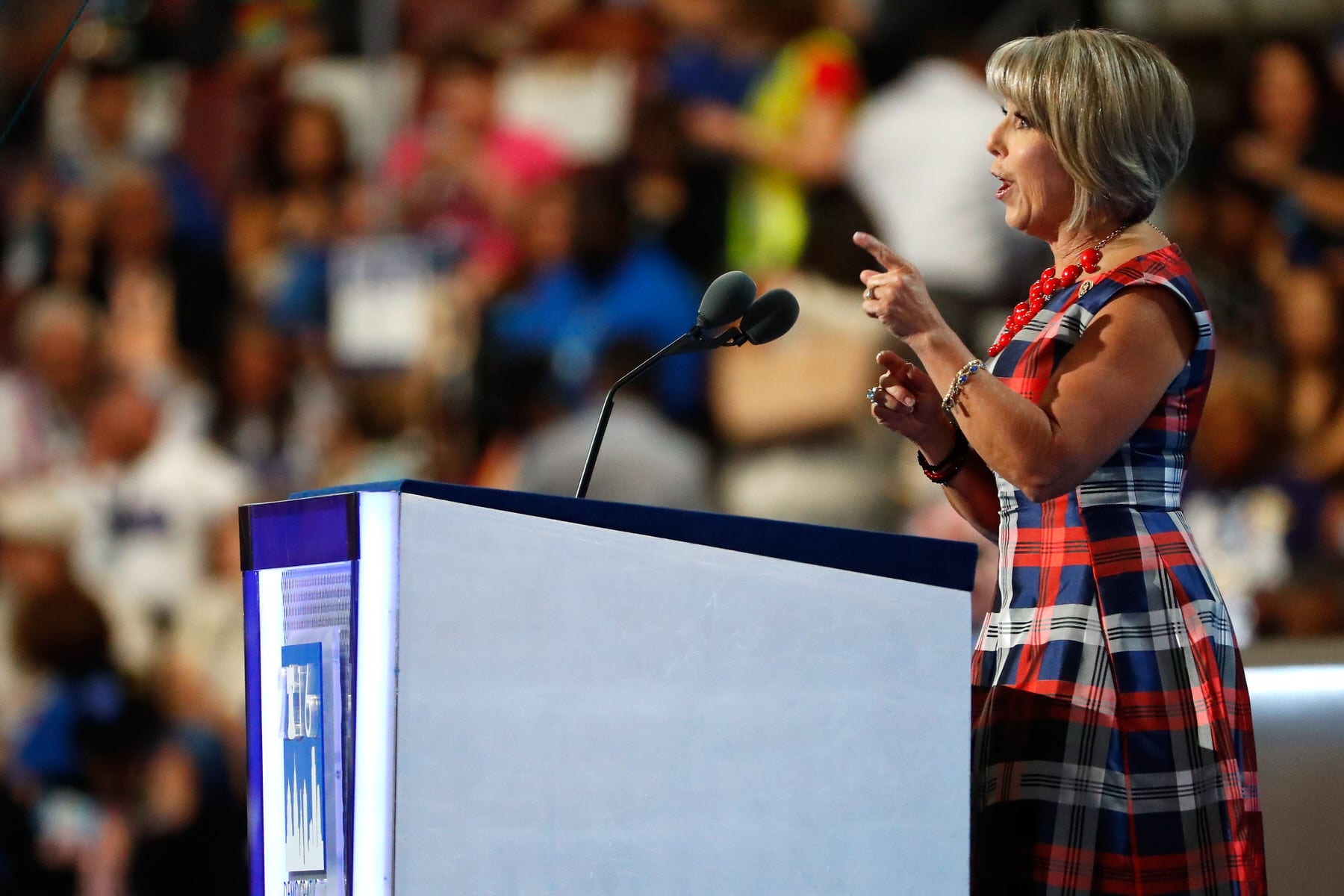In 2018, ahead of a reelection bid, Oregon Gov. Kate Brown raised nearly $20 million in the final sprint to Election Day. Her male Republican competitor, a state lawmaker, matched her — in part through large donations.
Brown had been governor since 2015, and previously served as Oregon’s secretary of state, a level of political power that few women had reached there. But the unprecedented amount of money in the race — she and her competitor raised more than $35 million, a record — meant Brown spent a lot of time fundraising.
“I had to raise one by one by one, and it took a lot of time and energy,” she said. “What I would say is this: My sense is we just need to spend, as a woman candidate, more time with our donors to convince them that we have both the leadership skills and the level of competence to do the job.”
Data backs Brown’s suspicion. The Center for American Women and Politics released a report late last year that concluded that women incumbent gubernatorial nominees face better-financed challengers than men incumbents. Another finding: Women gubernatorial candidates in primaries are more likely to have held elective office prior to running, a statistic that “may mean women have to be ‘better’ in order to raise comparable amounts of money.”
Brown ultimately won her race. Now, two years later, she and Gov. Michelle Lujan Grisham of New Mexico plan to chair the Women Governors Fund — a designated account through the Democratic Governors Association (DGA) — which will support Democratic women gubernatorial candidates.
The fund was created in 2018, and the DGA credits it with helping Democratic women win six governor’s races that year, including Brown and Lujan Grisham. This year there is a fundraising goal of $5 million (the fund had a $1 million goal in 2018), and it’s the first time governors will oversee the account. Brown and Lujan Grisham plan to travel around the country and lead fundraisers for the fund, which could be used for anything from advertising to field efforts.
Their commitment comes ahead of 36 governor’s races in 2022 — 20 seats currently held by Republicans and 16 seats currently held by Democrats.
“We have an obligation to remove key barriers, and certainly one of those is resources,” said Lujan Grisham, who is chair of the DGA. “So if we know that we’re not getting to the voters, that we’re not introducing them to these incredible women who by all accounts have incredible outcomes as executives, then we need to make sure that there’s a direct, finance-resource mechanism that is available to these up-and-coming statewide candidates.”
There are just eight women governors — five Democrats and three Republicans — making it one of the most underrepresented areas of government for women. (Former Rhode Island Democratic Gov. Gina Raimondo stepped down this year to join President Joe Biden’s Cabinet as commerce secretary). Seven of the governors are White women. Neither a Black woman nor a Native American woman has ever been elected governor.
“These races are generally less newsworthy than federal elections,” said Kira Sanbonmatsu, a political science professor at Rutgers University and senior scholar at its Center for American Women and Politics. “I don’t think that people fully understand the extent of women’s underrepresentation as governors.”
That is changing, especially after the coronavirus pandemic put a spotlight on statewide executive officials’ policy decisions on public health.
“The profile level of governors has been raised in the national consciousness as a result of the pandemic,” said Brown, who is the first out LGBTQ+ woman elected governor.
The outsized role of fundraising in governor’s races has come into focus in recent years. In a 2019 report, the Barbara Lee Family Foundation noted that “women candidates still report being excluded from financial circles that include the wealthiest and best-connected donors.”
CAWP’s report, in partnership with the National Institute on Money in Politics, concluded that Democratic women candidates are less likely than Democratic men to self-finance their campaigns. Thirteen percent of Democratic women’s total receipts are a result of self-financing, compared with 19 percent for Democratic men. (The proportion of funds from self-financing is similar for Republican women and men — about 20 percent.) The CAWP report noted a racial gap in fundraising: Women of color are less likely to rely on self-financing than White women.
Women gubernatorial candidates are also generally more reliant in their primaries on small contributions compared to men.
Another key dynamic to the dearth of women governors: Incumbent governors who seek reelection rarely lose their primaries. To date, 20 states have never elected a woman governor.
“If governors are seeking reelection, and they’re likely to win, that’s going to return mostly male governors,” Sanbonmatsu said. “So it is absolutely a vicious cycle.”
In Virginia, Terry McAuliffe, the state’s former governor, is running in an open Democratic primary to take back the position. That has given him an advantage in name recognition and fundraising, Sanbonmatsu said. Two women in the primary, former state delegate Jennifer Carroll Foy and state Sen. Jennifer McClellan, could become the first Black woman elected governor. But they have not raised as much money as McAuliffe, a White man and former national party official.
That highlights one of the limitations of the DGA fund. The money will not be used to help women candidates competing in primary races.
Sanbonmatsu said gubernatorial primaries are a critical stage to electing more women governors and women of color.
“If women aren’t entering the primary, then you’re less likely to nominate a woman,” Sanbonmatsu said. “Having promises of financial support help women enter and be successful in those primaries.”
Lujan Grisham acknowledged the missed opportunity of not helping primary candidates. She is the first Democratic Latina woman elected governor (only three women of color have been elected governors — Republicans Susana Martinez, also of New Mexico, and Nikki Haley of South Carolina, who are both no longer in office). Lujan Grisham described the fund as another tool in the toolbox, noting that recruitment groups will continue to play a key role along with fundraising arms of the national Democratic Party.
“We all have to be engaged in much better recruitment, training and support, particularly for women of color, and we are ready for them to win statewide office,” she said.
Martinez, the former governor of New Mexico, previously chaired the Republican Governors Association. The group did not respond to requests for comment.
Glynda Carr is CEO of Higher Heights for America, an organization that supports Black women’s political power. She said the short-term actions toward electing more women of color candidates, including governors, is investing in them early and with individual time and resources. She added that Higher Heights is embarking on a strategic planning process for Black women’s leadership and creating an “opportunity map” for the next few election cycles.
Carr pointed to the campaigns of Stacey Abrams, who nearly became America’s first elected Black woman governor in Georgia, and New York Attorney General Letitia James as successes. Abrams was first a state lawmaker who became a minority leader in the Georgia House of Representatives. James was a legislative staffer and city council member before she reached her executive position.
“Long term it is knowing that this leadership is attractive to voters. And so we should be actively seeking and positioning Black women to run for governors in the out years, so identifying a state legislator or a business owner or a statewide elected woman,” she said. “We should be having conversations about, ‘Are you interested in running in 2024? In 2026?’”
Sanbonmatsu echoed the importance of Abrams’ race in Georgia and wondered if it could preview more statewide bids in 2022.
“We were so close to having the first Black woman governor elected. So I think that there are signs of progress. And I think part of what we saw in the 2018 cycle, with the rise in women candidates and then the success of women in winning office — partly, we saw numbers go up for other statewide executive positions,” she said. “So that is encouraging because those women could in the future launch bids for governor.”
Brown is termed out from the governor’s office in 2022 because of state rules on seeking consecutive office. She said she plans to commit a lot of time to the women’s fund.
“I just think it’s really important that in 2021 we have to put our money where our values are and ensure that women running for governor have the resources they need to win,” she said. “And that has been a challenge. Over the decades we know that. Let’s make it happen.”






